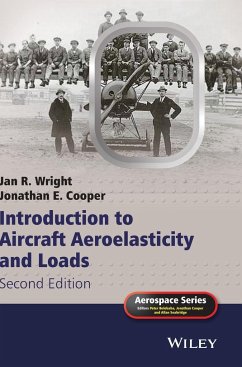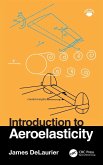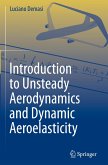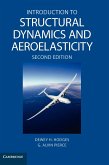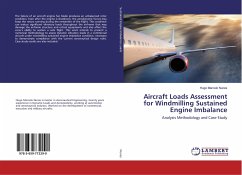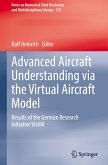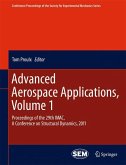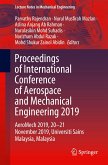Jan R Wright
Introduction to Aircraft Aeroelasticity and Loads
Herausgeber: Cooper, Jonathan; Seabridge, Allan; Belobaba, Peter
Jan R Wright
Introduction to Aircraft Aeroelasticity and Loads
Herausgeber: Cooper, Jonathan; Seabridge, Allan; Belobaba, Peter
- Gebundenes Buch
- Merkliste
- Auf die Merkliste
- Bewerten Bewerten
- Teilen
- Produkt teilen
- Produkterinnerung
- Produkterinnerung
Introduction to Aircraft Aeroelasticity and Loads, Second Edition is an updated new edition offering comprehensive coverage of the main principles of aircraft aeroelasticity and loads. For ease of reference, the book is divided into three parts and begins by reviewing the underlying disciplines of vibrations, aerodynamics, loads and control, and then goes on to describe simplified models to illustrate aeroelastic behaviour and aircraft response and loads for the flexible aircraft before introducing some more advanced methodologies. Finally, it explains how industrial certification requirements…mehr
Andere Kunden interessierten sich auch für
![Introduction to Aeroelasticity Introduction to Aeroelasticity]() James DelaurierIntroduction to Aeroelasticity143,99 €
James DelaurierIntroduction to Aeroelasticity143,99 €![Introduction to Unsteady Aerodynamics and Dynamic Aeroelasticity Introduction to Unsteady Aerodynamics and Dynamic Aeroelasticity]() Luciano DemasiIntroduction to Unsteady Aerodynamics and Dynamic Aeroelasticity68,99 €
Luciano DemasiIntroduction to Unsteady Aerodynamics and Dynamic Aeroelasticity68,99 €![Introduction to Structural Dynamics and Aeroelasticity Introduction to Structural Dynamics and Aeroelasticity]() Dewey H. HodgesIntroduction to Structural Dynamics and Aeroelasticity109,99 €
Dewey H. HodgesIntroduction to Structural Dynamics and Aeroelasticity109,99 €![Aircraft Loads Assessment for Windmilling Sustained Engine Imbalance Aircraft Loads Assessment for Windmilling Sustained Engine Imbalance]() Hugo Marcelo NunesAircraft Loads Assessment for Windmilling Sustained Engine Imbalance36,99 €
Hugo Marcelo NunesAircraft Loads Assessment for Windmilling Sustained Engine Imbalance36,99 €![Advanced Aircraft Understanding via the Virtual Aircraft Model Advanced Aircraft Understanding via the Virtual Aircraft Model]() Advanced Aircraft Understanding via the Virtual Aircraft Model112,99 €
Advanced Aircraft Understanding via the Virtual Aircraft Model112,99 €![Advanced Aerospace Applications, Volume 1 Advanced Aerospace Applications, Volume 1]() Advanced Aerospace Applications, Volume 1149,99 €
Advanced Aerospace Applications, Volume 1149,99 €![Proceedings of International Conference of Aerospace and Mechanical Engineering 2019 Proceedings of International Conference of Aerospace and Mechanical Engineering 2019]() Proceedings of International Conference of Aerospace and Mechanical Engineering 2019149,99 €
Proceedings of International Conference of Aerospace and Mechanical Engineering 2019149,99 €-
-
-
Introduction to Aircraft Aeroelasticity and Loads, Second Edition is an updated new edition offering comprehensive coverage of the main principles of aircraft aeroelasticity and loads. For ease of reference, the book is divided into three parts and begins by reviewing the underlying disciplines of vibrations, aerodynamics, loads and control, and then goes on to describe simplified models to illustrate aeroelastic behaviour and aircraft response and loads for the flexible aircraft before introducing some more advanced methodologies. Finally, it explains how industrial certification requirements for aeroelasticity and loads may be met and relates these to the earlier theoretical approaches used. Key features of this new edition include: - Uses a unified simple aeroelastic model throughout the book - Major revisions to chapters on aeroelasticity - Updates and reorganization of chapters involving Finite Elements - Some reorganization of loads material - Updates on certification requirements - Accompanied by a website containing a solutions manual, and MATLAB(R) and SIMULINK(R) programs that relate to the models used Introduction to Aircraft Aeroelasticity and Loads, Second Edition is a must-have reference for researchers and practitioners working in the aeroelasticity and loads fields, and is also an excellent textbook for senior undergraduate and graduate students in aerospace engineering.
Hinweis: Dieser Artikel kann nur an eine deutsche Lieferadresse ausgeliefert werden.
Hinweis: Dieser Artikel kann nur an eine deutsche Lieferadresse ausgeliefert werden.
Produktdetails
- Produktdetails
- Verlag: Wiley
- 2nd edition
- Seitenzahl: 576
- Erscheinungstermin: 23. Februar 2015
- Englisch
- Abmessung: 250mm x 175mm x 35mm
- Gewicht: 1159g
- ISBN-13: 9781118488010
- ISBN-10: 1118488016
- Artikelnr.: 41959449
- Herstellerkennzeichnung
- Libri GmbH
- Europaallee 1
- 36244 Bad Hersfeld
- gpsr@libri.de
- Verlag: Wiley
- 2nd edition
- Seitenzahl: 576
- Erscheinungstermin: 23. Februar 2015
- Englisch
- Abmessung: 250mm x 175mm x 35mm
- Gewicht: 1159g
- ISBN-13: 9781118488010
- ISBN-10: 1118488016
- Artikelnr.: 41959449
- Herstellerkennzeichnung
- Libri GmbH
- Europaallee 1
- 36244 Bad Hersfeld
- gpsr@libri.de
Multi-published author Cheryl Wright, former secretary, debt collector, account manager, writing instructor, and shopping tour hostess, loves reading.She writes historical and contemporary western romance, as well as small town romance and romantic suspense.She lives in a small village on the outskirts of Melbourne, Australia, and is married with two adult children and has six grandchildren. When she's not writing, she can be found in her craft room.
Series Preface xxi
Preface to the Second Edition xxiii
Preface to the First Edition xxv
Abbreviations xxix
Introduction 1
PART I BACKGROUND MATERIAL 7
1 Vibration of Single Degree of Freedom Systems 9
1.1 Setting up Equations of Motion for SDoF Systems 9
1.2 Free Vibration of SDoF Systems 11
1.3 Forced Vibration of SDoF Systems 13
1.4 Harmonic Forced Vibration - Frequency Response Functions 14
1.5 Transient/Random Forced Vibration - Time Domain Solution 17
1.6 Transient Forced Vibration - Frequency Domain Solution 21
1.7 Random Forced Vibration - Frequency Domain Solution 23
1.8 Examples 24
2 Vibration of Multiple Degree of Freedom Systems 27
2.1 Setting up Equations of Motion 27
2.2 Undamped Free Vibration 29
2.3 Damped Free Vibration 31
2.4 Transformation to Modal Coordinates 34
2.5 Two-DoF Rigid Aircraft in Heave and Pitch 38
2.6 'Free-Free' Systems 40
2.7 Harmonic Forced Vibration 41
2.8 Transient/Random Forced Vibration - Time Domain Solution 43
2.9 Transient Forced Vibration - Frequency Domain Solution 44
2.10 Random Forced Vibration - Frequency Domain Solution 44
2.11 Examples 45
3 Vibration of Continuous Systems - Assumed Shapes Approach 49
3.1 Continuous Systems 49
3.2 Modelling Continuous Systems 49
3.3 Elastic and Flexural Axes 51
3.4 Rayleigh-Ritz 'Assumed Shapes' Method 52
3.5 Generalized Equations of Motion - Basic Approach 53
3.6 Generalized Equations of Motion - Matrix Approach 58
3.7 Generating Whole Aircraft 'Free-Free' Modes from 'Branch' Modes 61
3.8 Whole Aircraft 'Free-Free' Modes 64
3.9 Examples 65
4 Introduction to Steady Aerodynamics 69
4.1 The Standard Atmosphere 69
4.2 Effect of Air Speed on Aerodynamic Characteristics 71
4.3 Flows and Pressures Around a Symmetric Aerofoil 73
4.4 Forces on an Aerofoil 74
4.5 Variation of Lift for an Aerofoil at an Angle of Incidence 76
4.6 Pitching Moment Variation and the Aerodynamic Centre 77
4.7 Lift on a Three-dimensional Wing 78
4.8 Drag on a Three-dimensional Wing 82
4.9 Control Surfaces 83
4.10 Transonic Flows 84
4.11 Examples 85
5 Introduction to Loads 87
5.1 Laws of Motion 88
5.2 D'Alembert's Principle - Inertia Forces and Couples 90
5.3 External Loads - Applied and Reactive 94
5.4 Free Body Diagrams 95
5.5 Internal Loads 96
5.6 Internal Loads for a Continuous Member 96
5.7 Internal Loads for a Discretized Member 101
5.8 Intercomponent Loads 103
5.9 Obtaining Stresses from Internal Loads - Structural Members with Simple
Load Paths 103
5.10 Examples 104
6 Introduction to Control 109
6.1 Open and Closed Loop Systems 109
6.2 Laplace Transforms 110
6.3 Modelling of Open and Closed Loop Systems using Laplace and Frequency
Domains 112
6.4 Stability of Systems 114
6.5 PID Control 121
6.6 Examples 122
PART II INTRODUCTION TO AEROELASTICITY AND LOADS 123
7 Static Aeroelasticity - Effect of Wing Flexibility on Lift Distribution
and Divergence 125
7.1 Static Aeroelastic Behaviour of a Two-dimensional Rigid Aerofoil with a
Torsional Spring Attachment 126
7.2 Static Aeroelastic Behaviour of a Fixed Root Flexible Wing 130
7.3 Effect of Trim on Static Aeroelastic Behaviour 133
7.4 Effect of Wing Sweep on Static Aeroelastic Behaviour 137
7.5 Examples 142
8 Static Aeroelasticity - Effect of Wing Flexibility on Control
Effectiveness 143
8.1 Rolling Effectiveness of a Flexible Wing - Fixed Wing Root Case 144
8.2 Rolling Effectiveness of a Flexible Wing - Steady Roll Case 147
8.3 Effect of Spanwise Position of the Control Surface 151
8.4 Full Aircraft Model - Control Effectiveness 152
8.5 Effect of Trim on Reversal Speed 153
8.6 Examples 153
9 Introduction to Unsteady Aerodynamics 155
9.1 Quasi-steady Aerodynamics 156
9.2 Unsteady Aerodynamics related to Motion 156
9.3 Aerodynamic Lift and Moment for an Aerofoil Oscillating Harmonically in
Heave and Pitch 161
9.4 Oscillatory Aerodynamic Derivatives 162
9.5 Aerodynamic Damping and Stiffness 163
9.6 Approximation of Unsteady Aerodynamic Terms 164
9.7 Unsteady Aerodynamics related to Gusts 164
9.8 Examples 168
10 Dynamic Aeroelasticity - Flutter 171
10.1 Simplified Unsteady Aerodynamic Model 172
10.2 Binary Aeroelastic Model 173
10.3 General Form of the Aeroelastic Equations 176
10.4 Eigenvalue Solution of the Flutter Equations 176
10.5 Aeroelastic Behaviour of the Binary Model 177
10.6 Aeroelastic Behaviour of a Multiple Mode System 185
10.7 Flutter Speed Prediction for Binary Systems 185
10.8 Divergence of Dynamic Aeroelastic Systems 188
10.9 Inclusion of Unsteady Reduced Frequency Effects 189
10.10 Control Surface Flutter 193
10.11 Whole Aircraft Model - Inclusion of Rigid Body Modes 199
10.12 Flutter in the Transonic Regime 202
10.13 Effect of Non-Linearities - Limit Cycle Oscillations 202
10.14 Examples 204
11 Aeroservoelasticity 207
11.1 Mathematical Modelling of a Simple Aeroelastic System with a Control
Surface 208
11.2 Inclusion of Gust Terms 209
11.3 Implementation of a Control System 210
11.4 Determination of Closed Loop System Stability 211
11.5 Gust Response of the Closed Loop System 213
11.6 Inclusion of Control Law Frequency Dependency in Stability
Calculations 214
11.7 Response Determination via the Frequency Domain 215
11.8 State Space Modelling 216
11.9 Examples 217
12 Equilibrium Manoeuvres 219
12.1 Equilibrium Manoeuvre - Rigid Aircraft under Normal Acceleration 221
12.2 Manoeuvre Envelope 226
12.3 Equilibrium Manoeuvre - Rigid Aircraft Pitching 227
12.4 Equilibrium Manoeuvre - Flexible Aircraft Pitching 235
12.5 Representation of the Flight Control System (FCS) 250
12.6 Examples 250
13 Dynamic Manoeuvres 253
13.1 Aircraft Axes 255
13.2 Motion Variables 257
13.3 Axes Transformations 257
13.4 Velocity and Acceleration Components for Moving Axes in 2D 259
13.5 Flight Mechanics Equations of Motion for a Rigid Symmetric Aircraft in
2D 262
13.6 Representation of Disturbing Forces and Moments 265
13.7 Modelling the Flexible Aircraft 267
13.8 Solution of Flight Mechanics Equations for the Rigid Aircraft 272
13.9 Dynamic Manoeuvre - Rigid Aircraft in Longitudinal Motion 273
13.10 Dynamic Manoeuvre - Flexible Aircraft Heave/Pitch 279
13.11 General Form of Longitudinal Equations 287
13.12 Dynamic Manoeuvre for Rigid Aircraft in Lateral Motion 288
13.13 Bookcase Manoeuvres for Rigid Aircraft in Lateral Motion 289
13.14 Flight Control System (FCS) 293
13.15 Representation of the Flight Control System (FCS) 295
13.16 Examples 295
14 Gust and Turbulence Encounters 299
14.1 Gusts and Turbulence 300
14.2 Gust Response in the Time Domain 301
14.3 Time Domain Gust Response - Rigid Aircraft in Heave 303
14.4 Time Domain Gust Response - Rigid Aircraft in Heave/Pitch 310
14.5 Time Domain Gust Response - Flexible Aircraft 316
14.6 General Form of Equations in the Time Domain 321
14.7 Turbulence Response in the Frequency Domain 321
14.8 Frequency Domain Turbulence Response - Rigid Aircraft in Heave 324
14.9 Frequency Domain Turbulence Response - Rigid Aircraft in Heave/Pitch
329
14.10 Frequency Domain Turbulence Response - Flexible Aircraft 330
14.11 General Form of Equations in the Frequency Domain 333
14.12 Representation of the Flight Control System (FCS) 334
14.13 Examples 334
15 Ground Manoeuvres 337
15.1 Landing Gear 337
15.2 Taxi, Take-Off and Landing Roll 342
15.3 Landing 351
15.4 Braking 359
15.5 Turning 360
15.6 Shimmy 361
15.7 Representation of the Flight Control System (FCS) 363
15.8 Examples 363
16 Aircraft Internal Loads 367
16.1 Limit and Ultimate Loads 368
16.2 Internal Loads for an Aircraft 368
16.3 General Internal Loads Expressions - Continuous Wing 370
16.4 Effect of Wing-mounted Engines and Landing Gear 372
16.5 Internal Loads - Continuous Flexible Wing 373
16.6 General Internal Loads Expressions - Discretized Wing 379
16.7 Internal Loads - Discretized Fuselage 384
16.8 Internal Loads - Continuous Turbulence Encounter 387
16.9 Loads Generation and Sorting to yield Critical Cases 388
16.10 Aircraft Dimensioning Cases 390
16.11 Stresses derived from Internal Loads - Complex Load Paths 391
16.12 Examples 391
17 Vibration of Continuous Systems - Finite Element Approach 395
17.1 Introduction to the Finite Element Approach 395
17.2 Formulation of the Beam Bending Element 397
17.3 Assembly and Solution for a Beam Structure 401
17.4 Torsion Element 406
17.5 Combined Bending/Torsion Element 407
17.6 Concentrated Mass Element 408
17.7 Stiffness Element 408
17.8 Rigid Body Elements 409
17.9 Other Elements 410
17.10 Comments on Modelling 411
17.11 Examples 413
18 Potential Flow Aerodynamics 415
18.1 Components of Inviscid, Incompressible Flow Analysis 415
18.2 Inclusion of Vorticity 420
18.3 Numerical Steady Aerodynamic Modelling of Thin Two-dimensional
Aerofoils 422
18.4 Steady Aerodynamic Modelling of Three-Dimensional Wings using a Panel
Method 425
18.5 Unsteady Aerodynamic Modelling of Wings undergoing Harmonic Motion 429
18.6 Aerodynamic Influence Coefficients in Modal Space 432
18.7 Examples 436
19 Coupling of Structural and Aerodynamic Computational Models 437
19.1 Mathematical Modelling - Static Aeroelastic Case 438
19.2 2D Coupled Static Aeroelastic Model - Pitch 439
19.3 2D Coupled Static Aeroelastic Model - Heave/Pitch 440
19.4 3D Coupled Static Aeroelastic Model 441
19.5 Mathematical Modelling - Dynamic Aeroelastic Response 446
19.6 2D Coupled Dynamic Aeroelastic Model - Bending/Torsion 447
19.7 3D Flutter Analysis 448
19.8 Inclusion of Frequency Dependent Aerodynamics for State-Space
Modelling - Rational Function Approximation 450
PART III INTRODUCTION TO INDUSTRIAL PRACTICE 455
20 Aircraft Design and Certification 457
20.1 Aeroelastics and Loads in the Aircraft Design Process 457
20.2 Aircraft Certification Process 459
21 Aeroelasticity and Loads Models 465
21.1 Structural Model 465
21.2 Aerodynamic Model 471
21.3 Flight Control System 473
21.4 Other Model Issues 474
21.5 Loads Transformations 474
22 Static Aeroelasticity and Flutter 475
22.1 Static Aeroelasticity 475
22.2 Flutter 478
23 Flight Manoeuvre and Gust/Turbulence Loads 481
23.1 Evaluation of Internal Loads 481
23.2 Equilibrium/Balanced Flight Manoeuvres 481
23.3 Dynamic Flight Manoeuvres 485
23.4 Gusts and Turbulence 489
24 Ground Manoeuvre Loads 495
24.1 Aircraft/Landing Gear Models for Ground Manoeuvres 495
24.2 Landing Gear/Airframe Interface 496
24.3 Ground Manoeuvres - Landing 496
24.4 Ground Manoeuvres - Ground Handling 497
24.5 Loads Processing 498
25 Testing Relevant to Aeroelasticity and Loads 501
25.1 Introduction 501
25.2 Wind Tunnel Tests 501
25.3 Ground Vibration Test 502
25.4 Structural Coupling Test 503
25.5 Flight Simulator Test 504
25.6 Structural Tests 504
25.7 Flight Flutter Test 505
25.8 Flight Loads Validation 507
Appendices 509
A Aircraft Rigid Body Modes 511
B Table of Longitudinal Aerodynamic Derivatives 513
C Aircraft Symmetric Flexible Modes 517
D Model Condensation 527
E Aerodynamic Derivatives in Body Fixed Axes 531
References 535
Index 539
Preface to the Second Edition xxiii
Preface to the First Edition xxv
Abbreviations xxix
Introduction 1
PART I BACKGROUND MATERIAL 7
1 Vibration of Single Degree of Freedom Systems 9
1.1 Setting up Equations of Motion for SDoF Systems 9
1.2 Free Vibration of SDoF Systems 11
1.3 Forced Vibration of SDoF Systems 13
1.4 Harmonic Forced Vibration - Frequency Response Functions 14
1.5 Transient/Random Forced Vibration - Time Domain Solution 17
1.6 Transient Forced Vibration - Frequency Domain Solution 21
1.7 Random Forced Vibration - Frequency Domain Solution 23
1.8 Examples 24
2 Vibration of Multiple Degree of Freedom Systems 27
2.1 Setting up Equations of Motion 27
2.2 Undamped Free Vibration 29
2.3 Damped Free Vibration 31
2.4 Transformation to Modal Coordinates 34
2.5 Two-DoF Rigid Aircraft in Heave and Pitch 38
2.6 'Free-Free' Systems 40
2.7 Harmonic Forced Vibration 41
2.8 Transient/Random Forced Vibration - Time Domain Solution 43
2.9 Transient Forced Vibration - Frequency Domain Solution 44
2.10 Random Forced Vibration - Frequency Domain Solution 44
2.11 Examples 45
3 Vibration of Continuous Systems - Assumed Shapes Approach 49
3.1 Continuous Systems 49
3.2 Modelling Continuous Systems 49
3.3 Elastic and Flexural Axes 51
3.4 Rayleigh-Ritz 'Assumed Shapes' Method 52
3.5 Generalized Equations of Motion - Basic Approach 53
3.6 Generalized Equations of Motion - Matrix Approach 58
3.7 Generating Whole Aircraft 'Free-Free' Modes from 'Branch' Modes 61
3.8 Whole Aircraft 'Free-Free' Modes 64
3.9 Examples 65
4 Introduction to Steady Aerodynamics 69
4.1 The Standard Atmosphere 69
4.2 Effect of Air Speed on Aerodynamic Characteristics 71
4.3 Flows and Pressures Around a Symmetric Aerofoil 73
4.4 Forces on an Aerofoil 74
4.5 Variation of Lift for an Aerofoil at an Angle of Incidence 76
4.6 Pitching Moment Variation and the Aerodynamic Centre 77
4.7 Lift on a Three-dimensional Wing 78
4.8 Drag on a Three-dimensional Wing 82
4.9 Control Surfaces 83
4.10 Transonic Flows 84
4.11 Examples 85
5 Introduction to Loads 87
5.1 Laws of Motion 88
5.2 D'Alembert's Principle - Inertia Forces and Couples 90
5.3 External Loads - Applied and Reactive 94
5.4 Free Body Diagrams 95
5.5 Internal Loads 96
5.6 Internal Loads for a Continuous Member 96
5.7 Internal Loads for a Discretized Member 101
5.8 Intercomponent Loads 103
5.9 Obtaining Stresses from Internal Loads - Structural Members with Simple
Load Paths 103
5.10 Examples 104
6 Introduction to Control 109
6.1 Open and Closed Loop Systems 109
6.2 Laplace Transforms 110
6.3 Modelling of Open and Closed Loop Systems using Laplace and Frequency
Domains 112
6.4 Stability of Systems 114
6.5 PID Control 121
6.6 Examples 122
PART II INTRODUCTION TO AEROELASTICITY AND LOADS 123
7 Static Aeroelasticity - Effect of Wing Flexibility on Lift Distribution
and Divergence 125
7.1 Static Aeroelastic Behaviour of a Two-dimensional Rigid Aerofoil with a
Torsional Spring Attachment 126
7.2 Static Aeroelastic Behaviour of a Fixed Root Flexible Wing 130
7.3 Effect of Trim on Static Aeroelastic Behaviour 133
7.4 Effect of Wing Sweep on Static Aeroelastic Behaviour 137
7.5 Examples 142
8 Static Aeroelasticity - Effect of Wing Flexibility on Control
Effectiveness 143
8.1 Rolling Effectiveness of a Flexible Wing - Fixed Wing Root Case 144
8.2 Rolling Effectiveness of a Flexible Wing - Steady Roll Case 147
8.3 Effect of Spanwise Position of the Control Surface 151
8.4 Full Aircraft Model - Control Effectiveness 152
8.5 Effect of Trim on Reversal Speed 153
8.6 Examples 153
9 Introduction to Unsteady Aerodynamics 155
9.1 Quasi-steady Aerodynamics 156
9.2 Unsteady Aerodynamics related to Motion 156
9.3 Aerodynamic Lift and Moment for an Aerofoil Oscillating Harmonically in
Heave and Pitch 161
9.4 Oscillatory Aerodynamic Derivatives 162
9.5 Aerodynamic Damping and Stiffness 163
9.6 Approximation of Unsteady Aerodynamic Terms 164
9.7 Unsteady Aerodynamics related to Gusts 164
9.8 Examples 168
10 Dynamic Aeroelasticity - Flutter 171
10.1 Simplified Unsteady Aerodynamic Model 172
10.2 Binary Aeroelastic Model 173
10.3 General Form of the Aeroelastic Equations 176
10.4 Eigenvalue Solution of the Flutter Equations 176
10.5 Aeroelastic Behaviour of the Binary Model 177
10.6 Aeroelastic Behaviour of a Multiple Mode System 185
10.7 Flutter Speed Prediction for Binary Systems 185
10.8 Divergence of Dynamic Aeroelastic Systems 188
10.9 Inclusion of Unsteady Reduced Frequency Effects 189
10.10 Control Surface Flutter 193
10.11 Whole Aircraft Model - Inclusion of Rigid Body Modes 199
10.12 Flutter in the Transonic Regime 202
10.13 Effect of Non-Linearities - Limit Cycle Oscillations 202
10.14 Examples 204
11 Aeroservoelasticity 207
11.1 Mathematical Modelling of a Simple Aeroelastic System with a Control
Surface 208
11.2 Inclusion of Gust Terms 209
11.3 Implementation of a Control System 210
11.4 Determination of Closed Loop System Stability 211
11.5 Gust Response of the Closed Loop System 213
11.6 Inclusion of Control Law Frequency Dependency in Stability
Calculations 214
11.7 Response Determination via the Frequency Domain 215
11.8 State Space Modelling 216
11.9 Examples 217
12 Equilibrium Manoeuvres 219
12.1 Equilibrium Manoeuvre - Rigid Aircraft under Normal Acceleration 221
12.2 Manoeuvre Envelope 226
12.3 Equilibrium Manoeuvre - Rigid Aircraft Pitching 227
12.4 Equilibrium Manoeuvre - Flexible Aircraft Pitching 235
12.5 Representation of the Flight Control System (FCS) 250
12.6 Examples 250
13 Dynamic Manoeuvres 253
13.1 Aircraft Axes 255
13.2 Motion Variables 257
13.3 Axes Transformations 257
13.4 Velocity and Acceleration Components for Moving Axes in 2D 259
13.5 Flight Mechanics Equations of Motion for a Rigid Symmetric Aircraft in
2D 262
13.6 Representation of Disturbing Forces and Moments 265
13.7 Modelling the Flexible Aircraft 267
13.8 Solution of Flight Mechanics Equations for the Rigid Aircraft 272
13.9 Dynamic Manoeuvre - Rigid Aircraft in Longitudinal Motion 273
13.10 Dynamic Manoeuvre - Flexible Aircraft Heave/Pitch 279
13.11 General Form of Longitudinal Equations 287
13.12 Dynamic Manoeuvre for Rigid Aircraft in Lateral Motion 288
13.13 Bookcase Manoeuvres for Rigid Aircraft in Lateral Motion 289
13.14 Flight Control System (FCS) 293
13.15 Representation of the Flight Control System (FCS) 295
13.16 Examples 295
14 Gust and Turbulence Encounters 299
14.1 Gusts and Turbulence 300
14.2 Gust Response in the Time Domain 301
14.3 Time Domain Gust Response - Rigid Aircraft in Heave 303
14.4 Time Domain Gust Response - Rigid Aircraft in Heave/Pitch 310
14.5 Time Domain Gust Response - Flexible Aircraft 316
14.6 General Form of Equations in the Time Domain 321
14.7 Turbulence Response in the Frequency Domain 321
14.8 Frequency Domain Turbulence Response - Rigid Aircraft in Heave 324
14.9 Frequency Domain Turbulence Response - Rigid Aircraft in Heave/Pitch
329
14.10 Frequency Domain Turbulence Response - Flexible Aircraft 330
14.11 General Form of Equations in the Frequency Domain 333
14.12 Representation of the Flight Control System (FCS) 334
14.13 Examples 334
15 Ground Manoeuvres 337
15.1 Landing Gear 337
15.2 Taxi, Take-Off and Landing Roll 342
15.3 Landing 351
15.4 Braking 359
15.5 Turning 360
15.6 Shimmy 361
15.7 Representation of the Flight Control System (FCS) 363
15.8 Examples 363
16 Aircraft Internal Loads 367
16.1 Limit and Ultimate Loads 368
16.2 Internal Loads for an Aircraft 368
16.3 General Internal Loads Expressions - Continuous Wing 370
16.4 Effect of Wing-mounted Engines and Landing Gear 372
16.5 Internal Loads - Continuous Flexible Wing 373
16.6 General Internal Loads Expressions - Discretized Wing 379
16.7 Internal Loads - Discretized Fuselage 384
16.8 Internal Loads - Continuous Turbulence Encounter 387
16.9 Loads Generation and Sorting to yield Critical Cases 388
16.10 Aircraft Dimensioning Cases 390
16.11 Stresses derived from Internal Loads - Complex Load Paths 391
16.12 Examples 391
17 Vibration of Continuous Systems - Finite Element Approach 395
17.1 Introduction to the Finite Element Approach 395
17.2 Formulation of the Beam Bending Element 397
17.3 Assembly and Solution for a Beam Structure 401
17.4 Torsion Element 406
17.5 Combined Bending/Torsion Element 407
17.6 Concentrated Mass Element 408
17.7 Stiffness Element 408
17.8 Rigid Body Elements 409
17.9 Other Elements 410
17.10 Comments on Modelling 411
17.11 Examples 413
18 Potential Flow Aerodynamics 415
18.1 Components of Inviscid, Incompressible Flow Analysis 415
18.2 Inclusion of Vorticity 420
18.3 Numerical Steady Aerodynamic Modelling of Thin Two-dimensional
Aerofoils 422
18.4 Steady Aerodynamic Modelling of Three-Dimensional Wings using a Panel
Method 425
18.5 Unsteady Aerodynamic Modelling of Wings undergoing Harmonic Motion 429
18.6 Aerodynamic Influence Coefficients in Modal Space 432
18.7 Examples 436
19 Coupling of Structural and Aerodynamic Computational Models 437
19.1 Mathematical Modelling - Static Aeroelastic Case 438
19.2 2D Coupled Static Aeroelastic Model - Pitch 439
19.3 2D Coupled Static Aeroelastic Model - Heave/Pitch 440
19.4 3D Coupled Static Aeroelastic Model 441
19.5 Mathematical Modelling - Dynamic Aeroelastic Response 446
19.6 2D Coupled Dynamic Aeroelastic Model - Bending/Torsion 447
19.7 3D Flutter Analysis 448
19.8 Inclusion of Frequency Dependent Aerodynamics for State-Space
Modelling - Rational Function Approximation 450
PART III INTRODUCTION TO INDUSTRIAL PRACTICE 455
20 Aircraft Design and Certification 457
20.1 Aeroelastics and Loads in the Aircraft Design Process 457
20.2 Aircraft Certification Process 459
21 Aeroelasticity and Loads Models 465
21.1 Structural Model 465
21.2 Aerodynamic Model 471
21.3 Flight Control System 473
21.4 Other Model Issues 474
21.5 Loads Transformations 474
22 Static Aeroelasticity and Flutter 475
22.1 Static Aeroelasticity 475
22.2 Flutter 478
23 Flight Manoeuvre and Gust/Turbulence Loads 481
23.1 Evaluation of Internal Loads 481
23.2 Equilibrium/Balanced Flight Manoeuvres 481
23.3 Dynamic Flight Manoeuvres 485
23.4 Gusts and Turbulence 489
24 Ground Manoeuvre Loads 495
24.1 Aircraft/Landing Gear Models for Ground Manoeuvres 495
24.2 Landing Gear/Airframe Interface 496
24.3 Ground Manoeuvres - Landing 496
24.4 Ground Manoeuvres - Ground Handling 497
24.5 Loads Processing 498
25 Testing Relevant to Aeroelasticity and Loads 501
25.1 Introduction 501
25.2 Wind Tunnel Tests 501
25.3 Ground Vibration Test 502
25.4 Structural Coupling Test 503
25.5 Flight Simulator Test 504
25.6 Structural Tests 504
25.7 Flight Flutter Test 505
25.8 Flight Loads Validation 507
Appendices 509
A Aircraft Rigid Body Modes 511
B Table of Longitudinal Aerodynamic Derivatives 513
C Aircraft Symmetric Flexible Modes 517
D Model Condensation 527
E Aerodynamic Derivatives in Body Fixed Axes 531
References 535
Index 539
Series Preface xxi
Preface to the Second Edition xxiii
Preface to the First Edition xxv
Abbreviations xxix
Introduction 1
PART I BACKGROUND MATERIAL 7
1 Vibration of Single Degree of Freedom Systems 9
1.1 Setting up Equations of Motion for SDoF Systems 9
1.2 Free Vibration of SDoF Systems 11
1.3 Forced Vibration of SDoF Systems 13
1.4 Harmonic Forced Vibration - Frequency Response Functions 14
1.5 Transient/Random Forced Vibration - Time Domain Solution 17
1.6 Transient Forced Vibration - Frequency Domain Solution 21
1.7 Random Forced Vibration - Frequency Domain Solution 23
1.8 Examples 24
2 Vibration of Multiple Degree of Freedom Systems 27
2.1 Setting up Equations of Motion 27
2.2 Undamped Free Vibration 29
2.3 Damped Free Vibration 31
2.4 Transformation to Modal Coordinates 34
2.5 Two-DoF Rigid Aircraft in Heave and Pitch 38
2.6 'Free-Free' Systems 40
2.7 Harmonic Forced Vibration 41
2.8 Transient/Random Forced Vibration - Time Domain Solution 43
2.9 Transient Forced Vibration - Frequency Domain Solution 44
2.10 Random Forced Vibration - Frequency Domain Solution 44
2.11 Examples 45
3 Vibration of Continuous Systems - Assumed Shapes Approach 49
3.1 Continuous Systems 49
3.2 Modelling Continuous Systems 49
3.3 Elastic and Flexural Axes 51
3.4 Rayleigh-Ritz 'Assumed Shapes' Method 52
3.5 Generalized Equations of Motion - Basic Approach 53
3.6 Generalized Equations of Motion - Matrix Approach 58
3.7 Generating Whole Aircraft 'Free-Free' Modes from 'Branch' Modes 61
3.8 Whole Aircraft 'Free-Free' Modes 64
3.9 Examples 65
4 Introduction to Steady Aerodynamics 69
4.1 The Standard Atmosphere 69
4.2 Effect of Air Speed on Aerodynamic Characteristics 71
4.3 Flows and Pressures Around a Symmetric Aerofoil 73
4.4 Forces on an Aerofoil 74
4.5 Variation of Lift for an Aerofoil at an Angle of Incidence 76
4.6 Pitching Moment Variation and the Aerodynamic Centre 77
4.7 Lift on a Three-dimensional Wing 78
4.8 Drag on a Three-dimensional Wing 82
4.9 Control Surfaces 83
4.10 Transonic Flows 84
4.11 Examples 85
5 Introduction to Loads 87
5.1 Laws of Motion 88
5.2 D'Alembert's Principle - Inertia Forces and Couples 90
5.3 External Loads - Applied and Reactive 94
5.4 Free Body Diagrams 95
5.5 Internal Loads 96
5.6 Internal Loads for a Continuous Member 96
5.7 Internal Loads for a Discretized Member 101
5.8 Intercomponent Loads 103
5.9 Obtaining Stresses from Internal Loads - Structural Members with Simple
Load Paths 103
5.10 Examples 104
6 Introduction to Control 109
6.1 Open and Closed Loop Systems 109
6.2 Laplace Transforms 110
6.3 Modelling of Open and Closed Loop Systems using Laplace and Frequency
Domains 112
6.4 Stability of Systems 114
6.5 PID Control 121
6.6 Examples 122
PART II INTRODUCTION TO AEROELASTICITY AND LOADS 123
7 Static Aeroelasticity - Effect of Wing Flexibility on Lift Distribution
and Divergence 125
7.1 Static Aeroelastic Behaviour of a Two-dimensional Rigid Aerofoil with a
Torsional Spring Attachment 126
7.2 Static Aeroelastic Behaviour of a Fixed Root Flexible Wing 130
7.3 Effect of Trim on Static Aeroelastic Behaviour 133
7.4 Effect of Wing Sweep on Static Aeroelastic Behaviour 137
7.5 Examples 142
8 Static Aeroelasticity - Effect of Wing Flexibility on Control
Effectiveness 143
8.1 Rolling Effectiveness of a Flexible Wing - Fixed Wing Root Case 144
8.2 Rolling Effectiveness of a Flexible Wing - Steady Roll Case 147
8.3 Effect of Spanwise Position of the Control Surface 151
8.4 Full Aircraft Model - Control Effectiveness 152
8.5 Effect of Trim on Reversal Speed 153
8.6 Examples 153
9 Introduction to Unsteady Aerodynamics 155
9.1 Quasi-steady Aerodynamics 156
9.2 Unsteady Aerodynamics related to Motion 156
9.3 Aerodynamic Lift and Moment for an Aerofoil Oscillating Harmonically in
Heave and Pitch 161
9.4 Oscillatory Aerodynamic Derivatives 162
9.5 Aerodynamic Damping and Stiffness 163
9.6 Approximation of Unsteady Aerodynamic Terms 164
9.7 Unsteady Aerodynamics related to Gusts 164
9.8 Examples 168
10 Dynamic Aeroelasticity - Flutter 171
10.1 Simplified Unsteady Aerodynamic Model 172
10.2 Binary Aeroelastic Model 173
10.3 General Form of the Aeroelastic Equations 176
10.4 Eigenvalue Solution of the Flutter Equations 176
10.5 Aeroelastic Behaviour of the Binary Model 177
10.6 Aeroelastic Behaviour of a Multiple Mode System 185
10.7 Flutter Speed Prediction for Binary Systems 185
10.8 Divergence of Dynamic Aeroelastic Systems 188
10.9 Inclusion of Unsteady Reduced Frequency Effects 189
10.10 Control Surface Flutter 193
10.11 Whole Aircraft Model - Inclusion of Rigid Body Modes 199
10.12 Flutter in the Transonic Regime 202
10.13 Effect of Non-Linearities - Limit Cycle Oscillations 202
10.14 Examples 204
11 Aeroservoelasticity 207
11.1 Mathematical Modelling of a Simple Aeroelastic System with a Control
Surface 208
11.2 Inclusion of Gust Terms 209
11.3 Implementation of a Control System 210
11.4 Determination of Closed Loop System Stability 211
11.5 Gust Response of the Closed Loop System 213
11.6 Inclusion of Control Law Frequency Dependency in Stability
Calculations 214
11.7 Response Determination via the Frequency Domain 215
11.8 State Space Modelling 216
11.9 Examples 217
12 Equilibrium Manoeuvres 219
12.1 Equilibrium Manoeuvre - Rigid Aircraft under Normal Acceleration 221
12.2 Manoeuvre Envelope 226
12.3 Equilibrium Manoeuvre - Rigid Aircraft Pitching 227
12.4 Equilibrium Manoeuvre - Flexible Aircraft Pitching 235
12.5 Representation of the Flight Control System (FCS) 250
12.6 Examples 250
13 Dynamic Manoeuvres 253
13.1 Aircraft Axes 255
13.2 Motion Variables 257
13.3 Axes Transformations 257
13.4 Velocity and Acceleration Components for Moving Axes in 2D 259
13.5 Flight Mechanics Equations of Motion for a Rigid Symmetric Aircraft in
2D 262
13.6 Representation of Disturbing Forces and Moments 265
13.7 Modelling the Flexible Aircraft 267
13.8 Solution of Flight Mechanics Equations for the Rigid Aircraft 272
13.9 Dynamic Manoeuvre - Rigid Aircraft in Longitudinal Motion 273
13.10 Dynamic Manoeuvre - Flexible Aircraft Heave/Pitch 279
13.11 General Form of Longitudinal Equations 287
13.12 Dynamic Manoeuvre for Rigid Aircraft in Lateral Motion 288
13.13 Bookcase Manoeuvres for Rigid Aircraft in Lateral Motion 289
13.14 Flight Control System (FCS) 293
13.15 Representation of the Flight Control System (FCS) 295
13.16 Examples 295
14 Gust and Turbulence Encounters 299
14.1 Gusts and Turbulence 300
14.2 Gust Response in the Time Domain 301
14.3 Time Domain Gust Response - Rigid Aircraft in Heave 303
14.4 Time Domain Gust Response - Rigid Aircraft in Heave/Pitch 310
14.5 Time Domain Gust Response - Flexible Aircraft 316
14.6 General Form of Equations in the Time Domain 321
14.7 Turbulence Response in the Frequency Domain 321
14.8 Frequency Domain Turbulence Response - Rigid Aircraft in Heave 324
14.9 Frequency Domain Turbulence Response - Rigid Aircraft in Heave/Pitch
329
14.10 Frequency Domain Turbulence Response - Flexible Aircraft 330
14.11 General Form of Equations in the Frequency Domain 333
14.12 Representation of the Flight Control System (FCS) 334
14.13 Examples 334
15 Ground Manoeuvres 337
15.1 Landing Gear 337
15.2 Taxi, Take-Off and Landing Roll 342
15.3 Landing 351
15.4 Braking 359
15.5 Turning 360
15.6 Shimmy 361
15.7 Representation of the Flight Control System (FCS) 363
15.8 Examples 363
16 Aircraft Internal Loads 367
16.1 Limit and Ultimate Loads 368
16.2 Internal Loads for an Aircraft 368
16.3 General Internal Loads Expressions - Continuous Wing 370
16.4 Effect of Wing-mounted Engines and Landing Gear 372
16.5 Internal Loads - Continuous Flexible Wing 373
16.6 General Internal Loads Expressions - Discretized Wing 379
16.7 Internal Loads - Discretized Fuselage 384
16.8 Internal Loads - Continuous Turbulence Encounter 387
16.9 Loads Generation and Sorting to yield Critical Cases 388
16.10 Aircraft Dimensioning Cases 390
16.11 Stresses derived from Internal Loads - Complex Load Paths 391
16.12 Examples 391
17 Vibration of Continuous Systems - Finite Element Approach 395
17.1 Introduction to the Finite Element Approach 395
17.2 Formulation of the Beam Bending Element 397
17.3 Assembly and Solution for a Beam Structure 401
17.4 Torsion Element 406
17.5 Combined Bending/Torsion Element 407
17.6 Concentrated Mass Element 408
17.7 Stiffness Element 408
17.8 Rigid Body Elements 409
17.9 Other Elements 410
17.10 Comments on Modelling 411
17.11 Examples 413
18 Potential Flow Aerodynamics 415
18.1 Components of Inviscid, Incompressible Flow Analysis 415
18.2 Inclusion of Vorticity 420
18.3 Numerical Steady Aerodynamic Modelling of Thin Two-dimensional
Aerofoils 422
18.4 Steady Aerodynamic Modelling of Three-Dimensional Wings using a Panel
Method 425
18.5 Unsteady Aerodynamic Modelling of Wings undergoing Harmonic Motion 429
18.6 Aerodynamic Influence Coefficients in Modal Space 432
18.7 Examples 436
19 Coupling of Structural and Aerodynamic Computational Models 437
19.1 Mathematical Modelling - Static Aeroelastic Case 438
19.2 2D Coupled Static Aeroelastic Model - Pitch 439
19.3 2D Coupled Static Aeroelastic Model - Heave/Pitch 440
19.4 3D Coupled Static Aeroelastic Model 441
19.5 Mathematical Modelling - Dynamic Aeroelastic Response 446
19.6 2D Coupled Dynamic Aeroelastic Model - Bending/Torsion 447
19.7 3D Flutter Analysis 448
19.8 Inclusion of Frequency Dependent Aerodynamics for State-Space
Modelling - Rational Function Approximation 450
PART III INTRODUCTION TO INDUSTRIAL PRACTICE 455
20 Aircraft Design and Certification 457
20.1 Aeroelastics and Loads in the Aircraft Design Process 457
20.2 Aircraft Certification Process 459
21 Aeroelasticity and Loads Models 465
21.1 Structural Model 465
21.2 Aerodynamic Model 471
21.3 Flight Control System 473
21.4 Other Model Issues 474
21.5 Loads Transformations 474
22 Static Aeroelasticity and Flutter 475
22.1 Static Aeroelasticity 475
22.2 Flutter 478
23 Flight Manoeuvre and Gust/Turbulence Loads 481
23.1 Evaluation of Internal Loads 481
23.2 Equilibrium/Balanced Flight Manoeuvres 481
23.3 Dynamic Flight Manoeuvres 485
23.4 Gusts and Turbulence 489
24 Ground Manoeuvre Loads 495
24.1 Aircraft/Landing Gear Models for Ground Manoeuvres 495
24.2 Landing Gear/Airframe Interface 496
24.3 Ground Manoeuvres - Landing 496
24.4 Ground Manoeuvres - Ground Handling 497
24.5 Loads Processing 498
25 Testing Relevant to Aeroelasticity and Loads 501
25.1 Introduction 501
25.2 Wind Tunnel Tests 501
25.3 Ground Vibration Test 502
25.4 Structural Coupling Test 503
25.5 Flight Simulator Test 504
25.6 Structural Tests 504
25.7 Flight Flutter Test 505
25.8 Flight Loads Validation 507
Appendices 509
A Aircraft Rigid Body Modes 511
B Table of Longitudinal Aerodynamic Derivatives 513
C Aircraft Symmetric Flexible Modes 517
D Model Condensation 527
E Aerodynamic Derivatives in Body Fixed Axes 531
References 535
Index 539
Preface to the Second Edition xxiii
Preface to the First Edition xxv
Abbreviations xxix
Introduction 1
PART I BACKGROUND MATERIAL 7
1 Vibration of Single Degree of Freedom Systems 9
1.1 Setting up Equations of Motion for SDoF Systems 9
1.2 Free Vibration of SDoF Systems 11
1.3 Forced Vibration of SDoF Systems 13
1.4 Harmonic Forced Vibration - Frequency Response Functions 14
1.5 Transient/Random Forced Vibration - Time Domain Solution 17
1.6 Transient Forced Vibration - Frequency Domain Solution 21
1.7 Random Forced Vibration - Frequency Domain Solution 23
1.8 Examples 24
2 Vibration of Multiple Degree of Freedom Systems 27
2.1 Setting up Equations of Motion 27
2.2 Undamped Free Vibration 29
2.3 Damped Free Vibration 31
2.4 Transformation to Modal Coordinates 34
2.5 Two-DoF Rigid Aircraft in Heave and Pitch 38
2.6 'Free-Free' Systems 40
2.7 Harmonic Forced Vibration 41
2.8 Transient/Random Forced Vibration - Time Domain Solution 43
2.9 Transient Forced Vibration - Frequency Domain Solution 44
2.10 Random Forced Vibration - Frequency Domain Solution 44
2.11 Examples 45
3 Vibration of Continuous Systems - Assumed Shapes Approach 49
3.1 Continuous Systems 49
3.2 Modelling Continuous Systems 49
3.3 Elastic and Flexural Axes 51
3.4 Rayleigh-Ritz 'Assumed Shapes' Method 52
3.5 Generalized Equations of Motion - Basic Approach 53
3.6 Generalized Equations of Motion - Matrix Approach 58
3.7 Generating Whole Aircraft 'Free-Free' Modes from 'Branch' Modes 61
3.8 Whole Aircraft 'Free-Free' Modes 64
3.9 Examples 65
4 Introduction to Steady Aerodynamics 69
4.1 The Standard Atmosphere 69
4.2 Effect of Air Speed on Aerodynamic Characteristics 71
4.3 Flows and Pressures Around a Symmetric Aerofoil 73
4.4 Forces on an Aerofoil 74
4.5 Variation of Lift for an Aerofoil at an Angle of Incidence 76
4.6 Pitching Moment Variation and the Aerodynamic Centre 77
4.7 Lift on a Three-dimensional Wing 78
4.8 Drag on a Three-dimensional Wing 82
4.9 Control Surfaces 83
4.10 Transonic Flows 84
4.11 Examples 85
5 Introduction to Loads 87
5.1 Laws of Motion 88
5.2 D'Alembert's Principle - Inertia Forces and Couples 90
5.3 External Loads - Applied and Reactive 94
5.4 Free Body Diagrams 95
5.5 Internal Loads 96
5.6 Internal Loads for a Continuous Member 96
5.7 Internal Loads for a Discretized Member 101
5.8 Intercomponent Loads 103
5.9 Obtaining Stresses from Internal Loads - Structural Members with Simple
Load Paths 103
5.10 Examples 104
6 Introduction to Control 109
6.1 Open and Closed Loop Systems 109
6.2 Laplace Transforms 110
6.3 Modelling of Open and Closed Loop Systems using Laplace and Frequency
Domains 112
6.4 Stability of Systems 114
6.5 PID Control 121
6.6 Examples 122
PART II INTRODUCTION TO AEROELASTICITY AND LOADS 123
7 Static Aeroelasticity - Effect of Wing Flexibility on Lift Distribution
and Divergence 125
7.1 Static Aeroelastic Behaviour of a Two-dimensional Rigid Aerofoil with a
Torsional Spring Attachment 126
7.2 Static Aeroelastic Behaviour of a Fixed Root Flexible Wing 130
7.3 Effect of Trim on Static Aeroelastic Behaviour 133
7.4 Effect of Wing Sweep on Static Aeroelastic Behaviour 137
7.5 Examples 142
8 Static Aeroelasticity - Effect of Wing Flexibility on Control
Effectiveness 143
8.1 Rolling Effectiveness of a Flexible Wing - Fixed Wing Root Case 144
8.2 Rolling Effectiveness of a Flexible Wing - Steady Roll Case 147
8.3 Effect of Spanwise Position of the Control Surface 151
8.4 Full Aircraft Model - Control Effectiveness 152
8.5 Effect of Trim on Reversal Speed 153
8.6 Examples 153
9 Introduction to Unsteady Aerodynamics 155
9.1 Quasi-steady Aerodynamics 156
9.2 Unsteady Aerodynamics related to Motion 156
9.3 Aerodynamic Lift and Moment for an Aerofoil Oscillating Harmonically in
Heave and Pitch 161
9.4 Oscillatory Aerodynamic Derivatives 162
9.5 Aerodynamic Damping and Stiffness 163
9.6 Approximation of Unsteady Aerodynamic Terms 164
9.7 Unsteady Aerodynamics related to Gusts 164
9.8 Examples 168
10 Dynamic Aeroelasticity - Flutter 171
10.1 Simplified Unsteady Aerodynamic Model 172
10.2 Binary Aeroelastic Model 173
10.3 General Form of the Aeroelastic Equations 176
10.4 Eigenvalue Solution of the Flutter Equations 176
10.5 Aeroelastic Behaviour of the Binary Model 177
10.6 Aeroelastic Behaviour of a Multiple Mode System 185
10.7 Flutter Speed Prediction for Binary Systems 185
10.8 Divergence of Dynamic Aeroelastic Systems 188
10.9 Inclusion of Unsteady Reduced Frequency Effects 189
10.10 Control Surface Flutter 193
10.11 Whole Aircraft Model - Inclusion of Rigid Body Modes 199
10.12 Flutter in the Transonic Regime 202
10.13 Effect of Non-Linearities - Limit Cycle Oscillations 202
10.14 Examples 204
11 Aeroservoelasticity 207
11.1 Mathematical Modelling of a Simple Aeroelastic System with a Control
Surface 208
11.2 Inclusion of Gust Terms 209
11.3 Implementation of a Control System 210
11.4 Determination of Closed Loop System Stability 211
11.5 Gust Response of the Closed Loop System 213
11.6 Inclusion of Control Law Frequency Dependency in Stability
Calculations 214
11.7 Response Determination via the Frequency Domain 215
11.8 State Space Modelling 216
11.9 Examples 217
12 Equilibrium Manoeuvres 219
12.1 Equilibrium Manoeuvre - Rigid Aircraft under Normal Acceleration 221
12.2 Manoeuvre Envelope 226
12.3 Equilibrium Manoeuvre - Rigid Aircraft Pitching 227
12.4 Equilibrium Manoeuvre - Flexible Aircraft Pitching 235
12.5 Representation of the Flight Control System (FCS) 250
12.6 Examples 250
13 Dynamic Manoeuvres 253
13.1 Aircraft Axes 255
13.2 Motion Variables 257
13.3 Axes Transformations 257
13.4 Velocity and Acceleration Components for Moving Axes in 2D 259
13.5 Flight Mechanics Equations of Motion for a Rigid Symmetric Aircraft in
2D 262
13.6 Representation of Disturbing Forces and Moments 265
13.7 Modelling the Flexible Aircraft 267
13.8 Solution of Flight Mechanics Equations for the Rigid Aircraft 272
13.9 Dynamic Manoeuvre - Rigid Aircraft in Longitudinal Motion 273
13.10 Dynamic Manoeuvre - Flexible Aircraft Heave/Pitch 279
13.11 General Form of Longitudinal Equations 287
13.12 Dynamic Manoeuvre for Rigid Aircraft in Lateral Motion 288
13.13 Bookcase Manoeuvres for Rigid Aircraft in Lateral Motion 289
13.14 Flight Control System (FCS) 293
13.15 Representation of the Flight Control System (FCS) 295
13.16 Examples 295
14 Gust and Turbulence Encounters 299
14.1 Gusts and Turbulence 300
14.2 Gust Response in the Time Domain 301
14.3 Time Domain Gust Response - Rigid Aircraft in Heave 303
14.4 Time Domain Gust Response - Rigid Aircraft in Heave/Pitch 310
14.5 Time Domain Gust Response - Flexible Aircraft 316
14.6 General Form of Equations in the Time Domain 321
14.7 Turbulence Response in the Frequency Domain 321
14.8 Frequency Domain Turbulence Response - Rigid Aircraft in Heave 324
14.9 Frequency Domain Turbulence Response - Rigid Aircraft in Heave/Pitch
329
14.10 Frequency Domain Turbulence Response - Flexible Aircraft 330
14.11 General Form of Equations in the Frequency Domain 333
14.12 Representation of the Flight Control System (FCS) 334
14.13 Examples 334
15 Ground Manoeuvres 337
15.1 Landing Gear 337
15.2 Taxi, Take-Off and Landing Roll 342
15.3 Landing 351
15.4 Braking 359
15.5 Turning 360
15.6 Shimmy 361
15.7 Representation of the Flight Control System (FCS) 363
15.8 Examples 363
16 Aircraft Internal Loads 367
16.1 Limit and Ultimate Loads 368
16.2 Internal Loads for an Aircraft 368
16.3 General Internal Loads Expressions - Continuous Wing 370
16.4 Effect of Wing-mounted Engines and Landing Gear 372
16.5 Internal Loads - Continuous Flexible Wing 373
16.6 General Internal Loads Expressions - Discretized Wing 379
16.7 Internal Loads - Discretized Fuselage 384
16.8 Internal Loads - Continuous Turbulence Encounter 387
16.9 Loads Generation and Sorting to yield Critical Cases 388
16.10 Aircraft Dimensioning Cases 390
16.11 Stresses derived from Internal Loads - Complex Load Paths 391
16.12 Examples 391
17 Vibration of Continuous Systems - Finite Element Approach 395
17.1 Introduction to the Finite Element Approach 395
17.2 Formulation of the Beam Bending Element 397
17.3 Assembly and Solution for a Beam Structure 401
17.4 Torsion Element 406
17.5 Combined Bending/Torsion Element 407
17.6 Concentrated Mass Element 408
17.7 Stiffness Element 408
17.8 Rigid Body Elements 409
17.9 Other Elements 410
17.10 Comments on Modelling 411
17.11 Examples 413
18 Potential Flow Aerodynamics 415
18.1 Components of Inviscid, Incompressible Flow Analysis 415
18.2 Inclusion of Vorticity 420
18.3 Numerical Steady Aerodynamic Modelling of Thin Two-dimensional
Aerofoils 422
18.4 Steady Aerodynamic Modelling of Three-Dimensional Wings using a Panel
Method 425
18.5 Unsteady Aerodynamic Modelling of Wings undergoing Harmonic Motion 429
18.6 Aerodynamic Influence Coefficients in Modal Space 432
18.7 Examples 436
19 Coupling of Structural and Aerodynamic Computational Models 437
19.1 Mathematical Modelling - Static Aeroelastic Case 438
19.2 2D Coupled Static Aeroelastic Model - Pitch 439
19.3 2D Coupled Static Aeroelastic Model - Heave/Pitch 440
19.4 3D Coupled Static Aeroelastic Model 441
19.5 Mathematical Modelling - Dynamic Aeroelastic Response 446
19.6 2D Coupled Dynamic Aeroelastic Model - Bending/Torsion 447
19.7 3D Flutter Analysis 448
19.8 Inclusion of Frequency Dependent Aerodynamics for State-Space
Modelling - Rational Function Approximation 450
PART III INTRODUCTION TO INDUSTRIAL PRACTICE 455
20 Aircraft Design and Certification 457
20.1 Aeroelastics and Loads in the Aircraft Design Process 457
20.2 Aircraft Certification Process 459
21 Aeroelasticity and Loads Models 465
21.1 Structural Model 465
21.2 Aerodynamic Model 471
21.3 Flight Control System 473
21.4 Other Model Issues 474
21.5 Loads Transformations 474
22 Static Aeroelasticity and Flutter 475
22.1 Static Aeroelasticity 475
22.2 Flutter 478
23 Flight Manoeuvre and Gust/Turbulence Loads 481
23.1 Evaluation of Internal Loads 481
23.2 Equilibrium/Balanced Flight Manoeuvres 481
23.3 Dynamic Flight Manoeuvres 485
23.4 Gusts and Turbulence 489
24 Ground Manoeuvre Loads 495
24.1 Aircraft/Landing Gear Models for Ground Manoeuvres 495
24.2 Landing Gear/Airframe Interface 496
24.3 Ground Manoeuvres - Landing 496
24.4 Ground Manoeuvres - Ground Handling 497
24.5 Loads Processing 498
25 Testing Relevant to Aeroelasticity and Loads 501
25.1 Introduction 501
25.2 Wind Tunnel Tests 501
25.3 Ground Vibration Test 502
25.4 Structural Coupling Test 503
25.5 Flight Simulator Test 504
25.6 Structural Tests 504
25.7 Flight Flutter Test 505
25.8 Flight Loads Validation 507
Appendices 509
A Aircraft Rigid Body Modes 511
B Table of Longitudinal Aerodynamic Derivatives 513
C Aircraft Symmetric Flexible Modes 517
D Model Condensation 527
E Aerodynamic Derivatives in Body Fixed Axes 531
References 535
Index 539

